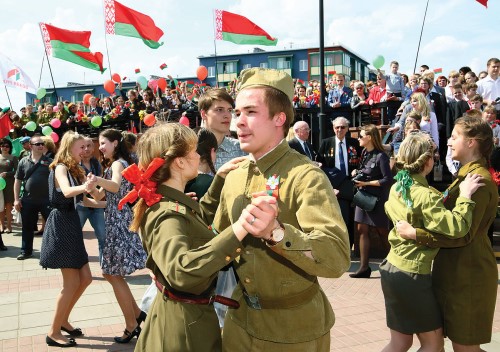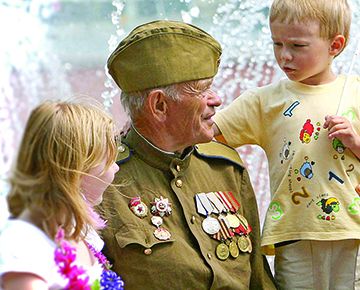
Chronicle of heroic deeds in Great Patriotic War years is transferred from generation to generation
Honouring shared memory
Near Minsk’s Hero-City Memorial, 300 men in biker gear proudly pose with veterans for their photograph, having ridden from Park Chelyuskintsev metro station, marking the 70th anniversary of the Victory of the Soviet people in the Great Patriotic War with their Harley-Davidson convoy.

The bikers view the Great Patriotic War as their personal history, notes Semen Nudelman, from Moscow. He tells us, “My father was a front-line soldier and lost his hand during the war. Our whole family suffered so it’s a significant date for us.”
The founder of the Harley-Davidson company in Minsk, Igor Podgorny, who helped organise the event, says, “Certainly, we couldn’t ignore such an important date; we had to honour the memory of our grandfathers. Moreover, we want to show that people of various nationalities and citizenship can not only peacefully exist but enjoy friendship. Our convoy comprises diverse members but all are united by a peaceful idea.”

Bikers on Pobediteley Avenue
Harley clubs from Belarus, Russia (including from Moscow, St. Petersburg, and Krasnodar), Poland and the Baltic States took part in the gathering, echoing their journey of last year, when they laid flowers at the Mound of Glory.
By Dmitry Ampilov
Defenders of the Homeland in line
Spectacular festive parade to honour 70th anniversary of Victory.
The Minsk parade on May 9th is expected to gather over 5,000 military men and around 250 combat vehicles, attracting students from military universities and departments, the parade squads of the State Customs Committee, troops from the Interior Ministry and the Emergency Ministry, and members of Russia’s Armed Forces. As is traditional, the parade will be led by cadets from the Minsk Suvorov Military College, followed by the Victory Banner and the standards of the 1st, 2nd and 3rd Belarusian and 1st Baltic fronts (which took part in Operation Bagration).

Military equipment of the past — obligatory for the holiday
The latter part of the parade will feature war time machinery and samples of modern weaponry and military vehicles, including some iconic pieces of military hardware, such as tanks and Katyusha rocket launch platforms; these will be followed by powerful armoured cars, air defence systems, and artillery and rocket systems. For the first time, a significant share of the machinery will come from Russia, representing regional troops: the latest tanks, light-armoured cars and self-propelled artillery platforms. Over 300 Russian military men and around 30 military vehicles have already arrived in the country.
Closing the parade will be an aviation fly-past, featuring dozens of aircraft: helicopters, fighter-planes and strike aircraft. Russian pilots will demonstrate their mastery alongside Belarusian. Finally, there will be a festive concert, featuring a silent drill platoon and a combined orchestra from the Belarusian Armed Forces.
By Inna Gorbatenkova
See you on parade!
Contours of commemorating the 70th anniversary of Great Patriotic War Victory.
The Minsk parade is to feature a 30-gun salute at 10pm and traditional celebrations. As usual, a section along Pobediteley Avenue, near the Sports Palace, will become the major festive ground. Leading musicians will perform at the Blossoming May concert, and the holiday will also feature various craftsmen and sports competitions. Evening illuminations will light up the capital, including across the suburbs. At least a million people will take part in activities in Minsk alone, with about 300,000 watching the parade.
The Press Secretary of the Main Directorate of Ideological Work, of the Ministry of Defence, Vladimir Makarov, advises us to arrive in good time for the 11am parade, which is due to last about an hour.
The Deputy Head of Sports and Tourism Department at Minsk’s City Executive Committee, Svetlana Demeshko, notes that the parade will be shorter than last year’s, with about 3,000 people involved: including those working in sports, students and pupils. A vase is to be ‘built’ by about 450 participants and the procession will be accompanied by Belarusian athletes’ demonstration performances.
By Denis Ampilov
Museum ‘arrives on schedule’
Over 12 days, Flower of Great Victory train visits every regional centre and large stations, returning to Minsk on May 5th.

Welcoming of propaganda train in Grodno
The train’s six carriages and engine represent the seven decades separating us from Victory Day, operating as a mobile museum, displaying 1941-1945 exhibits. Some items of military hardware are also displayed on an open-air platform, such as a 45mm anti-tank gun (used by Soviet soldiers in Berlin). Wartime songs play at each ‘stop’ and a documentary entitled My Film About War is available for viewing, showing veterans’ recollections. The train is also collecting letters to veterans, for delivery to those brave former soldiers.
By Yekaterina Kopyleva
Hero-cities to be filled with lovely lilac
Proposal by Council of Botanical Gardens of Russia and Belarus to plant lilac avenues in each of the hero-cities, to mark the 70th anniversary of the end of the Great Patriotic War, now coming to fruition.
NAS academician Vladimir Reshetnikov, who heads biochemistry and biotechnology at the Central Botanical Garden, tells us that double-flowering white lilac seedlings (called ‘To Defenders of Brest’ and ‘Marat Kazey’) have now been delivered to Volgograd while Belarus is to plant ‘Lights of Moscow’, ‘Salute of Moscow’, ‘Great Victory’ and ‘Alexey Maresiev’. The task is to introduce 16 varieties (on the military theme) across all 13 hero-cities. The honoured worker of science is leading organisation on the Belarusian side.
The new varieties of lilac have all been given names devoted to the theme of the Great Patriotic War and its heroes: for example, ‘Valentina Grizodubova’, ‘Captain Gastello’, ‘Marshal Zhukov’ and ‘Marshal Vasilevsky’. The Victory Lilac motion is to bring avenues to Minsk’s Loshitsa estate and park complex, to the Pobeda museum-park complex and to Brest, near the walls of the fortress complex. Avenues are to be laid in Volgograd, Sevastopol, Kerch, Novorossiysk, Tula, Smolensk, Moscow and St. Petersburg, producing a riot of colour: a salute in honour to Victory.
By Olga Voronaeva











